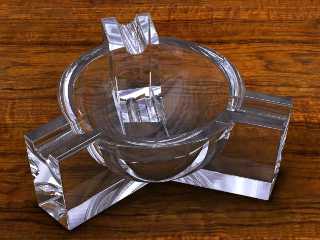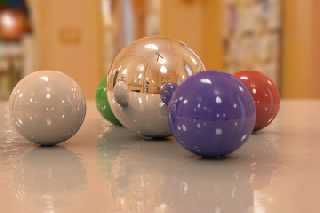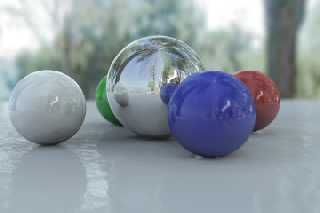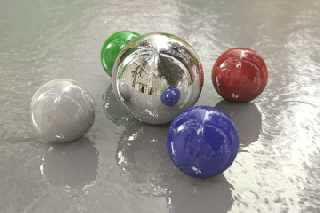 |
 |
|
 |
|
 |
|  |
|  |
|
 |
|
 |
|  |
|  |
|
 |
Hi all,
the images made with HDRI have a really amazing lighting.
And as far as I can see there is not so much effort in
setting the scene lights.
So I tried to make a similiar thing. It's a sphere with
a mapped picture for lighting, traced with radiosity of
course.
When I see the result I think there is not much difference
compared to the HDRI method.
So my question:
What is the advantage of HDRI?
Maybe I'm blind...
-C-H-A-R-L-E-S-
Post a reply to this message
Attachments:
Download 'tray.jpg' (52 KB)
Preview of image 'tray.jpg'

|
 |
|  |
|  |
|
 |
|
 |
|  |
|  |
|
 |
Your image is a bit dark. When I look in the glass, I would expect the sky
to be brighter and the road darker (if it's a road) and the table more lit.
This is what HDRI is for. On the other hand I agree, this HDRI thing is a
bit overrated. Some says it's the holy grale! But higher contrasts in
image_maps, used as faked enviroment, is more realistic. With radiosity, I'm
fairly confident it gives a better result than a mere 24-bit image, because
radiosity calculations react to light intensities above 1 (a white rgb)...
But with reflections, the docs says "POV-Ray uses a limited light model that
cannot distinguish between objects which are simply brightly colored and
objects which are extremely bright" therefore we have the
reflection_exponent keyword... So that shouldn't work in favor of HDR, but
I'm not fully certain about it.
Btw, you haven't used interpolation of your image_map, have you?
Regards,
Hugo
Post a reply to this message
|
 |
|  |
|  |
|
 |
|
 |
|  |
|  |
|
 |
"Hugo Asm" <hua### [at] post3 tele tele dk> schrieb im Newsbeitrag
news:3e1560f2@news.povray.org...
Hi Hugo,
thanks for the clarification.
> Your image is a bit dark. When I look in the glass, I would expect the sky
It's intended like it is.
> Btw, you haven't used interpolation of your image_map, have you?
Right, it was a quick and dirty test.
And the size of the image is very small.
-C-H-A-R-L-E-S- dk> schrieb im Newsbeitrag
news:3e1560f2@news.povray.org...
Hi Hugo,
thanks for the clarification.
> Your image is a bit dark. When I look in the glass, I would expect the sky
It's intended like it is.
> Btw, you haven't used interpolation of your image_map, have you?
Right, it was a quick and dirty test.
And the size of the image is very small.
-C-H-A-R-L-E-S-
Post a reply to this message
|
 |
|  |
|  |
|
 |
|
 |
|  |
|  |
|
 |
Hi all,
IMHO:
In [quickly] reading the SIGGRAPH paper that started all this (at
http://www.debevec.org) it seems that HDRI is not for 100% "virtual" scenes.
It seems that the idea is to take a "real" scene, i.e. a photograph and use
the HDR as a basis for lighting virtual objects so they fit into the scene
realistically. To quote the author from his paper "Rendering Synthetic
Objects Into Real Scenes":
"Rendering synthetic objects into real-world scenes is an important
application of computer graphics...Oftentimes, a peice of furniture, a prop,
or a digital creature or actor needs to be rendered seamlessly into a real
scene. This diffucult task requires that the objects be lit consistently
with the surfaces in their vicinity, and that the interplay of light between
the objects and their surroundings be properly simulated..."
...and so on. This is the real advantage of HDRI and Mael's patch. Not to
take anything away from the astounding HDRI images that have appeared here
in this NG, but I don't feel that any of the images posted reflect the
purpose of HDRI rendering. Instead, HDRI simply provides them with a
shortcut to good lighting. This aspect has been duplicated by yourself and
Jaime (and any image with good lighting, I guess). Therefore, I too, ask
why HDRI?
"Charles Panke" <cha### [at] t-online de> wrote in message
news:3e15581b@news.povray.org...
> Hi all,
>
> the images made with HDRI have a really amazing lighting.
> And as far as I can see there is not so much effort in
> setting the scene lights.
>
> So I tried to make a similiar thing. It's a sphere with
> a mapped picture for lighting, traced with radiosity of
> course.
> When I see the result I think there is not much difference
> compared to the HDRI method.
>
> So my question:
> What is the advantage of HDRI?
>
> Maybe I'm blind...
>
> -C-H-A-R-L-E-S-
>
>
>
> de> wrote in message
news:3e15581b@news.povray.org...
> Hi all,
>
> the images made with HDRI have a really amazing lighting.
> And as far as I can see there is not so much effort in
> setting the scene lights.
>
> So I tried to make a similiar thing. It's a sphere with
> a mapped picture for lighting, traced with radiosity of
> course.
> When I see the result I think there is not much difference
> compared to the HDRI method.
>
> So my question:
> What is the advantage of HDRI?
>
> Maybe I'm blind...
>
> -C-H-A-R-L-E-S-
>
>
>
>
Post a reply to this message
|
 |
|  |
|  |
|
 |
|
 |
|  |
|  |
|
 |
On Fri, 3 Jan 2003 08:07:20 -0500
"cadman" <REM### [at] povray co co uk> wrote:
> Therefore, I too, ask why HDRI?
Because, appart from being almost necessary to create "augmented
reality", it is a very cheap way to fake a complete environment for
close-up shots, including the lighting, with maximum realism.
Indeed, I've made some more tests with "faked HDRI", this time with
a 255 layers texture. The first layer is the simple image_map with
ambient, and the other 254 are done with a grayscale version of the
same image, using exponential transmit. Not bad results, and very
quick to render (well, not much more slow than a single layer
texture).
--
Jaime Vives Piqueres
La Persistencia de la Ignorancia
http://www.ignorancia.org uk> wrote:
> Therefore, I too, ask why HDRI?
Because, appart from being almost necessary to create "augmented
reality", it is a very cheap way to fake a complete environment for
close-up shots, including the lighting, with maximum realism.
Indeed, I've made some more tests with "faked HDRI", this time with
a 255 layers texture. The first layer is the simple image_map with
ambient, and the other 254 are done with a grayscale version of the
same image, using exponential transmit. Not bad results, and very
quick to render (well, not much more slow than a single layer
texture).
--
Jaime Vives Piqueres
La Persistencia de la Ignorancia
http://www.ignorancia.org
Post a reply to this message
Attachments:
Download 'test-dri-b1.jpg' (23 KB)
Download 'test-dri-b2.jpg' (27 KB)
Download 'test-dri-b3.jpg' (40 KB)
Preview of image 'test-dri-b1.jpg'

Preview of image 'test-dri-b2.jpg'

Preview of image 'test-dri-b3.jpg'

|
 |
|  |
|  |
|
 |
|
 |
|  |
|  |
|
 |
Quite right. It is intended for compositing rendered objects into
captured images. What bothers me about the images posted
here is that the background environment looks out of focus,
lacks detail, and is low contrast. I think this has to do with the
detail present in the HDR image map. However, as Cadman
has said, the original intent was to provide accurate lighting
for rendered objects, then composite these rendered
object into another, more detailed, environment.
The technique is not for computer rendering purists who
consider the use of photographic maps to be cheating. For
my images I like to combine stereoscopic photographs with
stereoscopic rendered objects. HDRI will be great for
these images.
HB
"cadman" <REM### [at] povray co co uk> wrote in message
news:3e158abe$1@news.povray.org...
> Hi all,
>
> IMHO:
>
> In [quickly] reading the SIGGRAPH paper that started all this (at
> http://www.debevec.org) it seems that HDRI is not for 100% "virtual"
scenes.
> It seems that the idea is to take a "real" scene, i.e. a photograph and
use
> the HDR as a basis for lighting virtual objects so they fit into the scene
> realistically. To quote the author from his paper "Rendering Synthetic
> Objects Into Real Scenes":
>
> "Rendering synthetic objects into real-world scenes is an important
> application of computer graphics...Oftentimes, a peice of furniture, a
prop,
> or a digital creature or actor needs to be rendered seamlessly into a real
> scene. This diffucult task requires that the objects be lit consistently
> with the surfaces in their vicinity, and that the interplay of light
between
> the objects and their surroundings be properly simulated..."
>
> ...and so on. This is the real advantage of HDRI and Mael's patch. Not
to
> take anything away from the astounding HDRI images that have appeared here
> in this NG, but I don't feel that any of the images posted reflect the
> purpose of HDRI rendering. Instead, HDRI simply provides them with a
> shortcut to good lighting. This aspect has been duplicated by yourself
and
> Jaime (and any image with good lighting, I guess). Therefore, I too, ask
> why HDRI?
>
>
> "Charles Panke" <cha### [at] t-online uk> wrote in message
news:3e158abe$1@news.povray.org...
> Hi all,
>
> IMHO:
>
> In [quickly] reading the SIGGRAPH paper that started all this (at
> http://www.debevec.org) it seems that HDRI is not for 100% "virtual"
scenes.
> It seems that the idea is to take a "real" scene, i.e. a photograph and
use
> the HDR as a basis for lighting virtual objects so they fit into the scene
> realistically. To quote the author from his paper "Rendering Synthetic
> Objects Into Real Scenes":
>
> "Rendering synthetic objects into real-world scenes is an important
> application of computer graphics...Oftentimes, a peice of furniture, a
prop,
> or a digital creature or actor needs to be rendered seamlessly into a real
> scene. This diffucult task requires that the objects be lit consistently
> with the surfaces in their vicinity, and that the interplay of light
between
> the objects and their surroundings be properly simulated..."
>
> ...and so on. This is the real advantage of HDRI and Mael's patch. Not
to
> take anything away from the astounding HDRI images that have appeared here
> in this NG, but I don't feel that any of the images posted reflect the
> purpose of HDRI rendering. Instead, HDRI simply provides them with a
> shortcut to good lighting. This aspect has been duplicated by yourself
and
> Jaime (and any image with good lighting, I guess). Therefore, I too, ask
> why HDRI?
>
>
> "Charles Panke" <cha### [at] t-online de> wrote in message
> news:3e15581b@news.povray.org...
> > Hi all,
> >
> > the images made with HDRI have a really amazing lighting.
> > And as far as I can see there is not so much effort in
> > setting the scene lights.
> >
> > So I tried to make a similiar thing. It's a sphere with
> > a mapped picture for lighting, traced with radiosity of
> > course.
> > When I see the result I think there is not much difference
> > compared to the HDRI method.
> >
> > So my question:
> > What is the advantage of HDRI?
> >
> > Maybe I'm blind...
> >
> > -C-H-A-R-L-E-S-
> >
> >
> >
> >
>
> de> wrote in message
> news:3e15581b@news.povray.org...
> > Hi all,
> >
> > the images made with HDRI have a really amazing lighting.
> > And as far as I can see there is not so much effort in
> > setting the scene lights.
> >
> > So I tried to make a similiar thing. It's a sphere with
> > a mapped picture for lighting, traced with radiosity of
> > course.
> > When I see the result I think there is not much difference
> > compared to the HDRI method.
> >
> > So my question:
> > What is the advantage of HDRI?
> >
> > Maybe I'm blind...
> >
> > -C-H-A-R-L-E-S-
> >
> >
> >
> >
>
>
Post a reply to this message
|
 |
|  |
|  |
|
 |
|
 |
|  |
|  |
|
 |
Wow, what did you use as the texture for that table? Or is it image mapped?
Mike
"Charles Panke" <cha### [at] t-online de> wrote in message
news:3e15581b@news.povray.org...
> Hi all,
>
> the images made with HDRI have a really amazing lighting.
> And as far as I can see there is not so much effort in
> setting the scene lights.
>
> So I tried to make a similiar thing. It's a sphere with
> a mapped picture for lighting, traced with radiosity of
> course.
> When I see the result I think there is not much difference
> compared to the HDRI method.
>
> So my question:
> What is the advantage of HDRI?
>
> Maybe I'm blind...
>
> -C-H-A-R-L-E-S-
>
>
>
> de> wrote in message
news:3e15581b@news.povray.org...
> Hi all,
>
> the images made with HDRI have a really amazing lighting.
> And as far as I can see there is not so much effort in
> setting the scene lights.
>
> So I tried to make a similiar thing. It's a sphere with
> a mapped picture for lighting, traced with radiosity of
> course.
> When I see the result I think there is not much difference
> compared to the HDRI method.
>
> So my question:
> What is the advantage of HDRI?
>
> Maybe I'm blind...
>
> -C-H-A-R-L-E-S-
>
>
>
>
Post a reply to this message
|
 |
|  |
|  |
|
 |
|
 |
|  |
|  |
|
 |
"Charles Panke" <cha### [at] t-online de> wrote in message
news:3e15581b@news.povray.org...
Is it me, or is that table repeated three times in some places??
Whatever, nice image though.
~Steve~
> -C-H-A-R-L-E-S-
>
>
>
> de> wrote in message
news:3e15581b@news.povray.org...
Is it me, or is that table repeated three times in some places??
Whatever, nice image though.
~Steve~
> -C-H-A-R-L-E-S-
>
>
>
>
Post a reply to this message
|
 |
|  |
|  |
|
 |
|
 |
|  |
|  |
|
 |
> What is the advantage of HDRI?
Have you tried to render the same image using HDRI?
Maybe that will give you the possibility to see the advantages
and disadvantages of the method (and sure it will answer your
question better than us)
Bye
Txemi Jendrix
http://www.txemijendrix.com
Post a reply to this message
|
 |
|  |
|  |
|
 |
|
 |
|  |
|  |
|
 |
Jaime Vives Piqueres wrote:
> Not bad results...
Heh, you win!
That is very nice work, but where are the photons?
Could you work a crystal ball into your test scene and show refraction and
reflection working with the fake HDRI environment?
Post a reply to this message
|
 |
|  |
|  |
|
 |
|
 |
|  |
|
 |




![]()